Saturday, May 20: Firenze
Sadly, I fell asleep on my first Italian high-speed train and missed most of the Tuscan countryside, although not all—I did wake up to take a gander at a tiny unidentified cluster of ancient buildings on one hilltop, and Orvieto on another.
We arrived in Florence, picked up Firenze passes at the tourist information across from the train station, and trundled our suitcases across Piazza Santa Maria Novella in front of a majestic church, ducking down narrow Via la Spada to look for no. 3. This was complicated by a two-tier numbering system in Florence, blue for businesses and red for residences. Finally we found the apartment and the greeters, Miki and Marco.
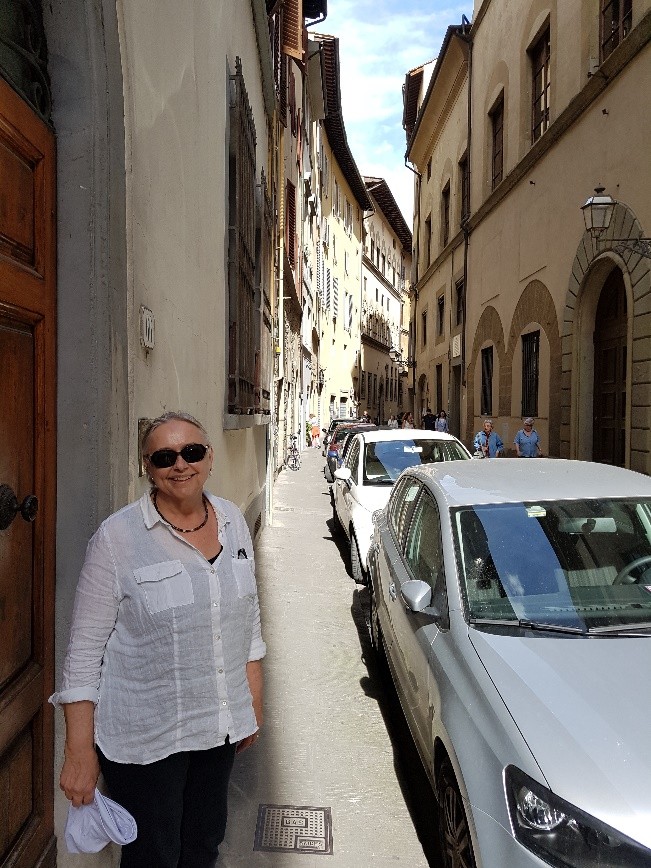
Compared to our little troglodyte place in Rome, our new apartment was beautiful. The lofty marble entrance hall featured a large elevator to carry people and bags with room left over. The stairs climbed in wide treads in an open square around the elevator, and mostly we took those (stair climbing was one of our workouts). A door from the stair landing led into a hallway with marble floors and gilded cases of elegant bric-a-brac, off of which was our apartment door.
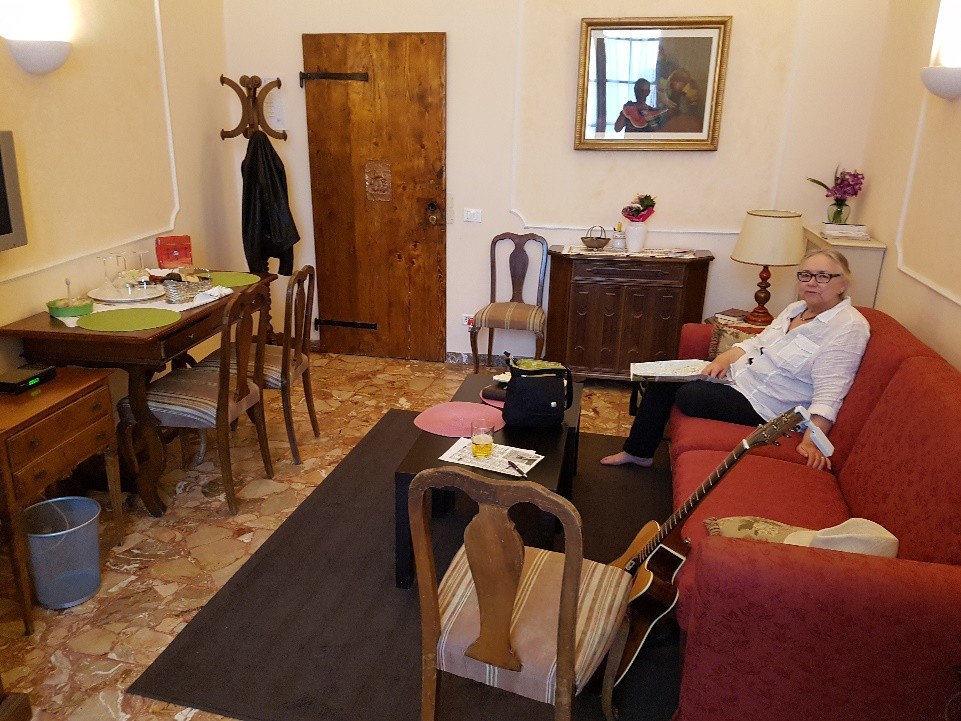
Living room and bedroom had tall, tall ceilings (no one will bump his head here!), nicely tinted plaster walls with mouldings, tall windows with interior shutters and lavish treatments to keep out heat during the day and light at night.
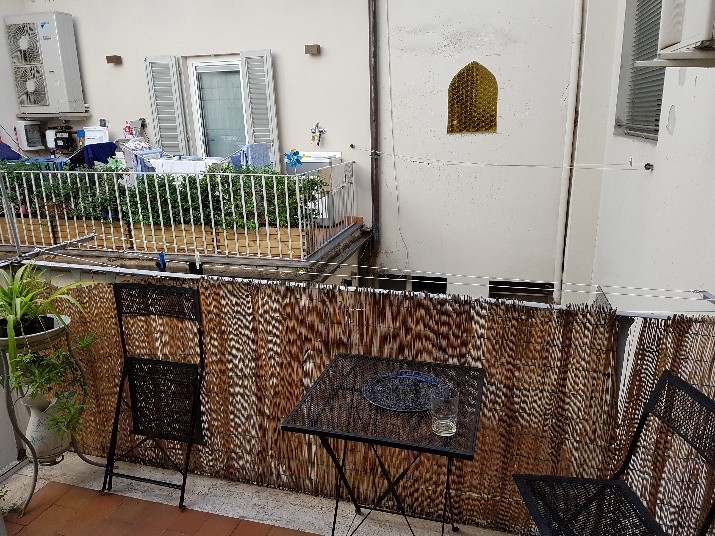
A little balcony perched outside the tall living room windows.

The bed was big and comfortable, the marble floors were cool.

The kitchen was in an armoire in the living room, but actually was well set up with a convection stovetop, sink, draining rack, dish shelving, and a small refrigerator. Miki had gotten us a bottle of Prosecco for our anniversary, and a bouquet of flowers! And another bottle of wine, a big bottle of Italian birra, and a couple of madelines. Plus, we had olive oil and vinegar, salt and pepper, sugar and teabags, and coffee. Marco produced a bag for the American coffeemaker, but Miki brought an opened bag (much better, she said) for the espresso maker. And butter, several pats she proudly showed me.
Our afternoon program called for a walk across the Ponte Vecchio to the Piazzale Michelangelo, from which a panoramic view of Florence could be obtained. I also wanted to go to the church above the piazzale, San Minato, built where Minias, a holy Armenian hermit, had died. Supposedly, he was brought from his hermitage to Florence, condemned as a heretic, and beheaded, after which he picked up his head and went back across the Arno to finish dying at home.
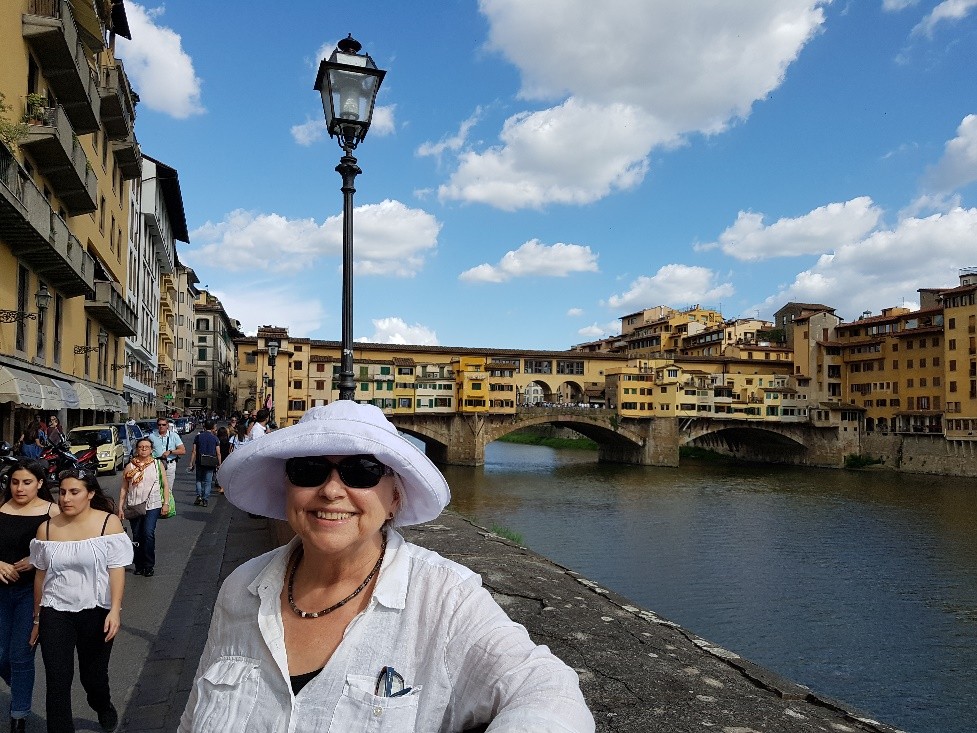
Leaving our apartment, we were directly across from the Strozzi Palace, with the Duomo visible in the distance. We turned left toward the Arno, pausing to admire the river and the perfect sky.
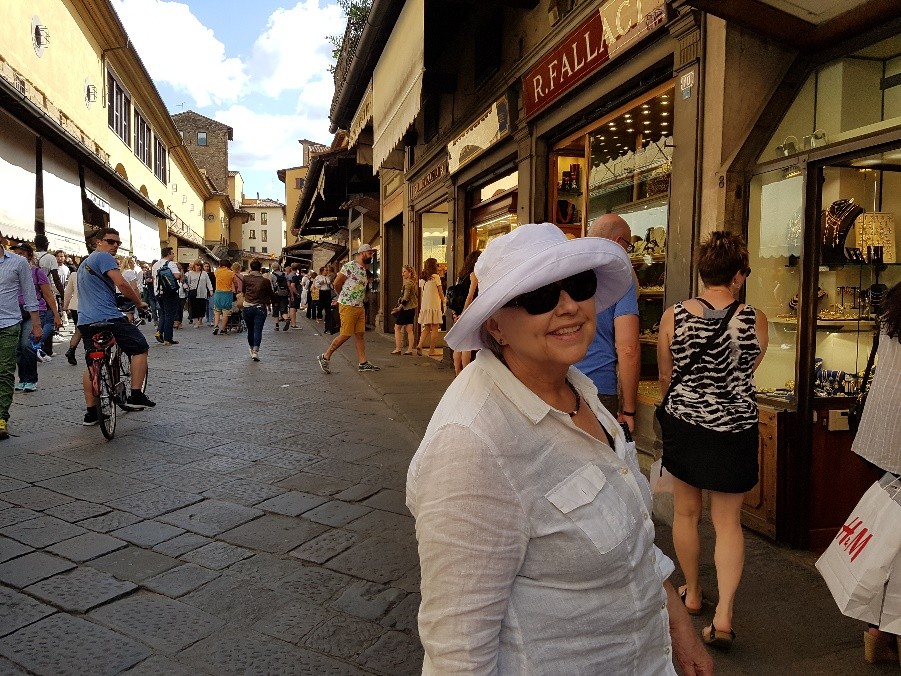
We pushed our way across the Ponte Vecchio, admiring the gold dripping down in every window. Trudging up steep streets and even steeper stairs to reach the Piazzale, I was even more admiring of Minias’ feat.
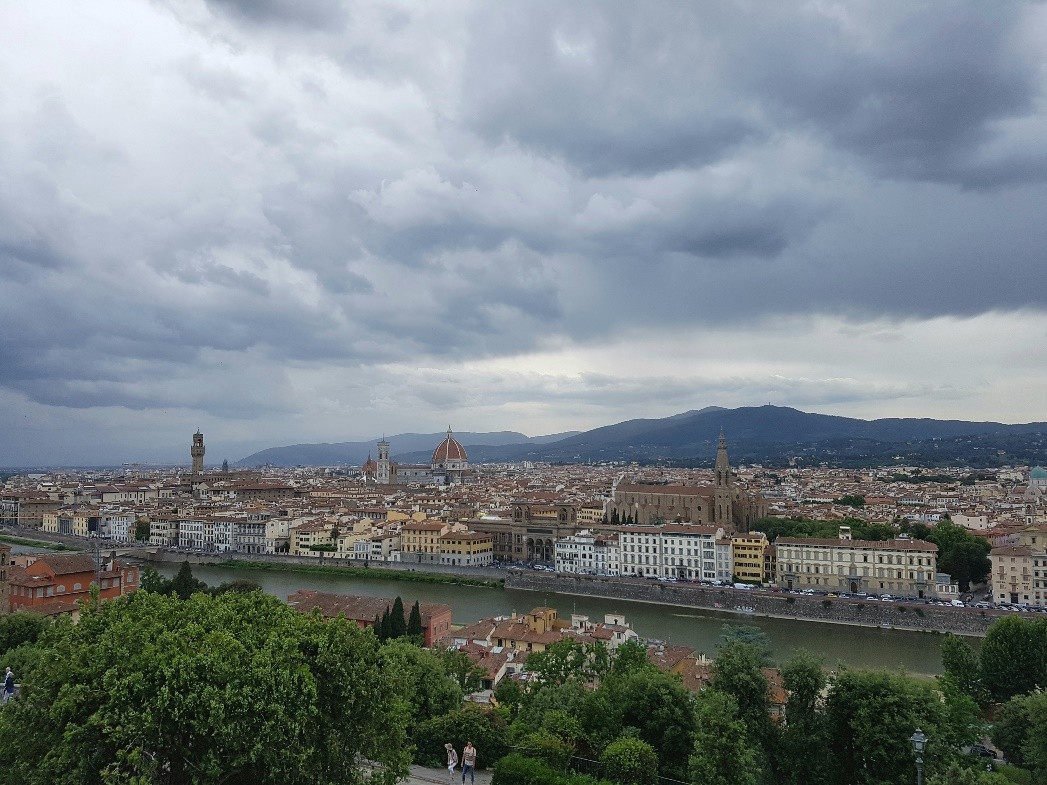
We took our pictures, admired the view, and were actually relieved to see that there was no point to keep climbing up further steep stairs to the church, since a wedding was taking place there.
As we trudged back down the hill (my knees were killing me), dark clouds began to gather. We stopped at the “supermarket” we had passed on the way up and by the time we left the store, it was sprinkling. As we crossed the Ponte Vecchio, it began raining. By the time we were on our side of the river, it was really raining and we were powerwalking.
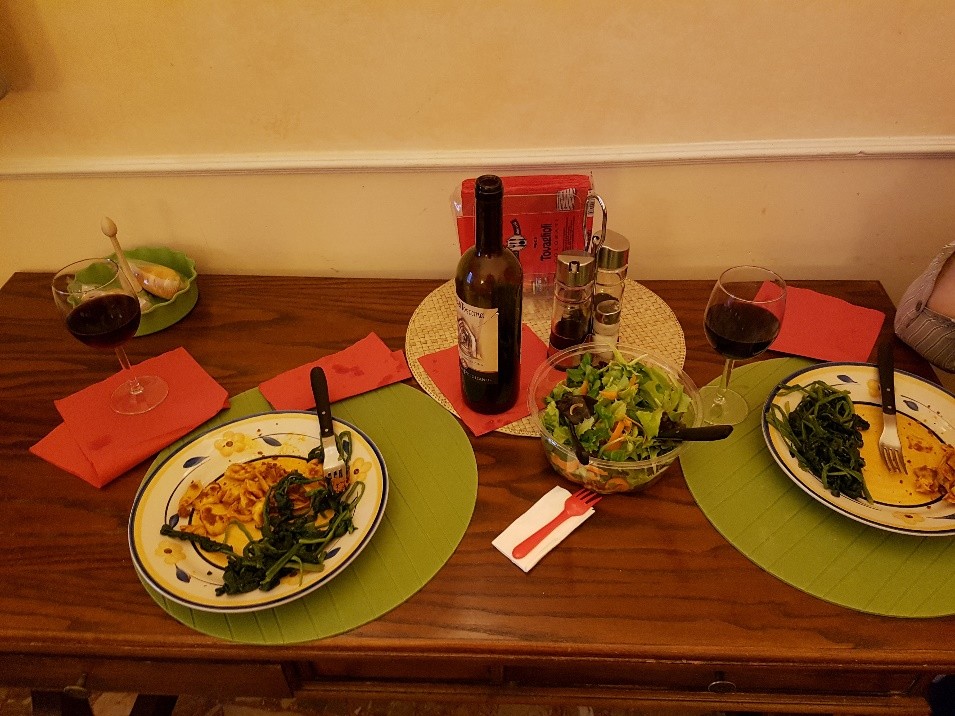
We had our take-out meal with the bottle of wine Miki was kind enough to leave us.
Sunday, May 21
Slept in and figured out the shower, the kettles, the kitchen/closet, our breakfast, and caffeine. Finally headed for the Uffizi around noon with our Firenze cards, which were supposed to get us in anywhere without standing in lines. We did get in pretty quickly compared with the horde waiting in line at the courtyard entrance.
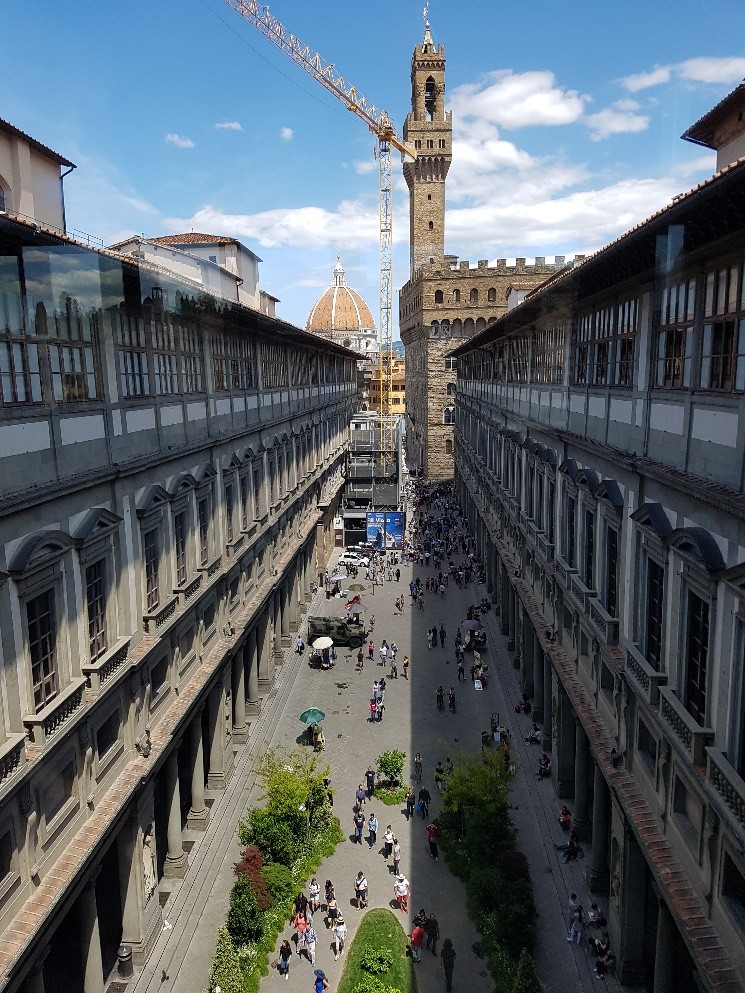
I was looking for Bottecelli, and I found him. Amazing to see La Primavera on the wall instead of the page.
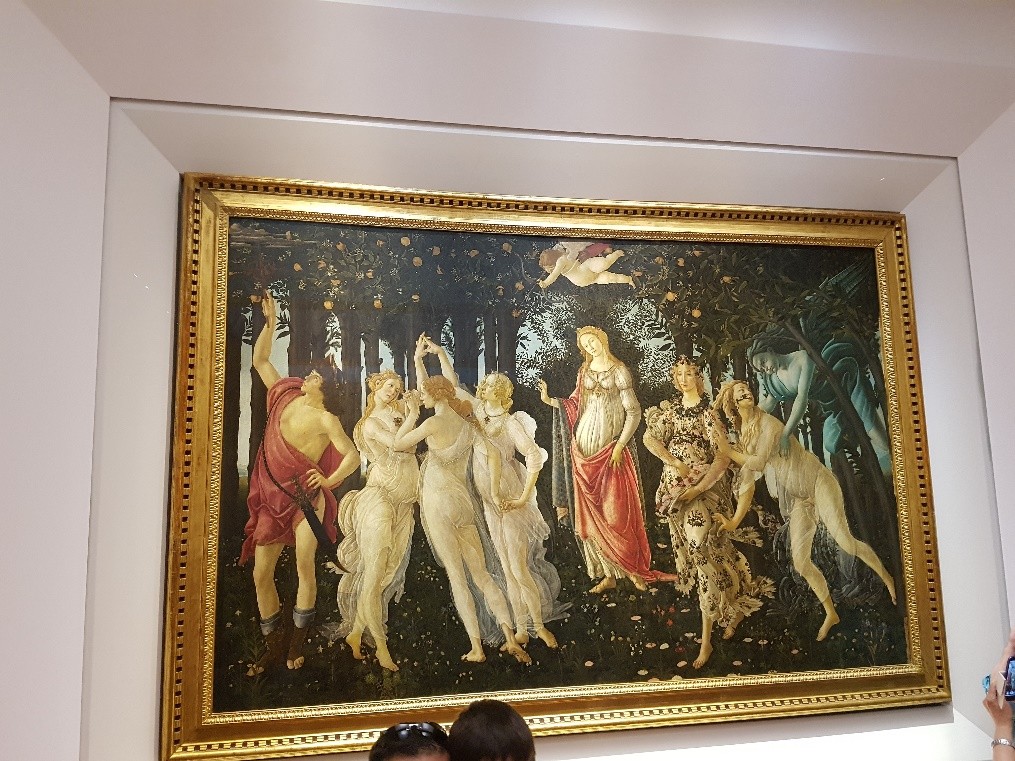
Even more amazing to see the Birth of Venus. As with Monet’s Lunch on the Grass, you don’t realize the monumental size of these canvases until you see them in person.
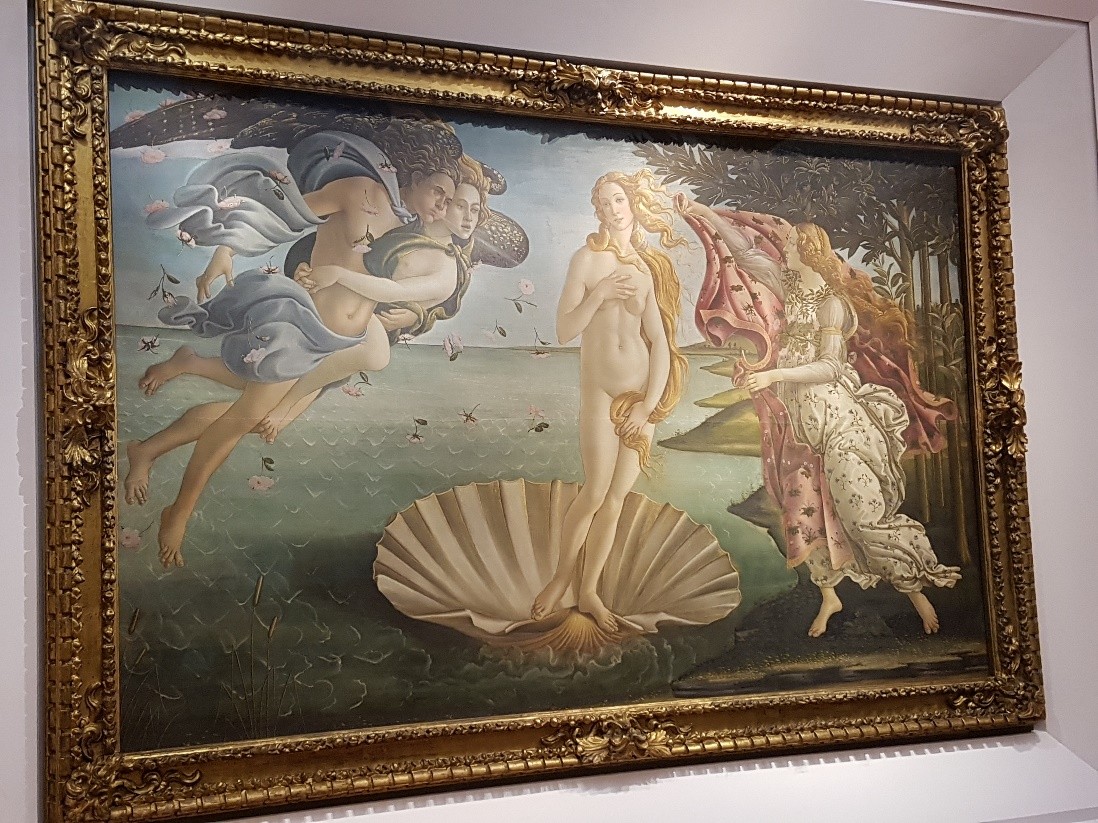
Jerr, the non-museum-goer, was a real trooper. He took pictures of the pictures, didn’t complain, and trudged through the galleries with me.
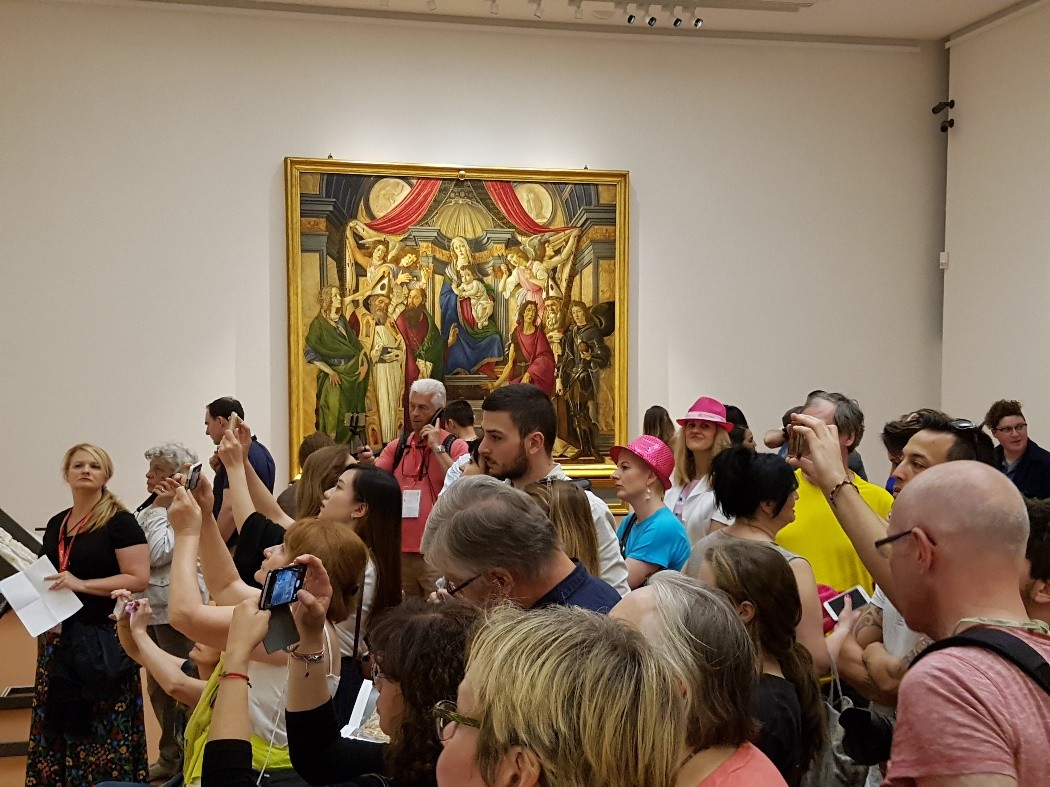
It was pretty crowded. Prairie-dogging was required for some pictures.

The Medici decorating style was—opulent.
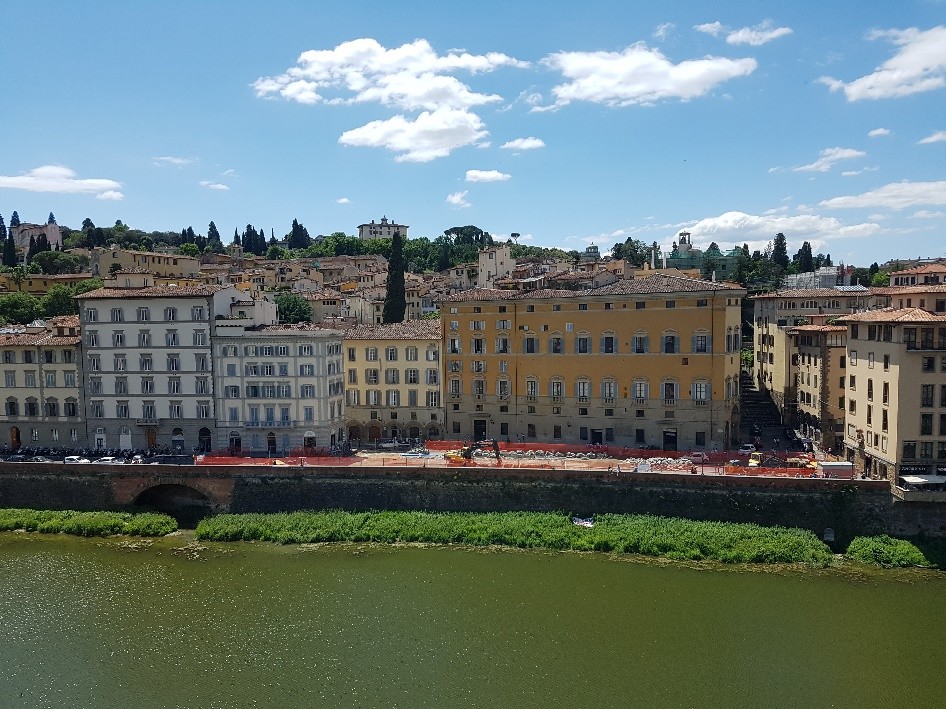
From the upper floor of the Uffizi, good views are obtained of the Oltrarno (other side of the Arno) and the Ponte Vecchio

A private rowing club has that green lawn.
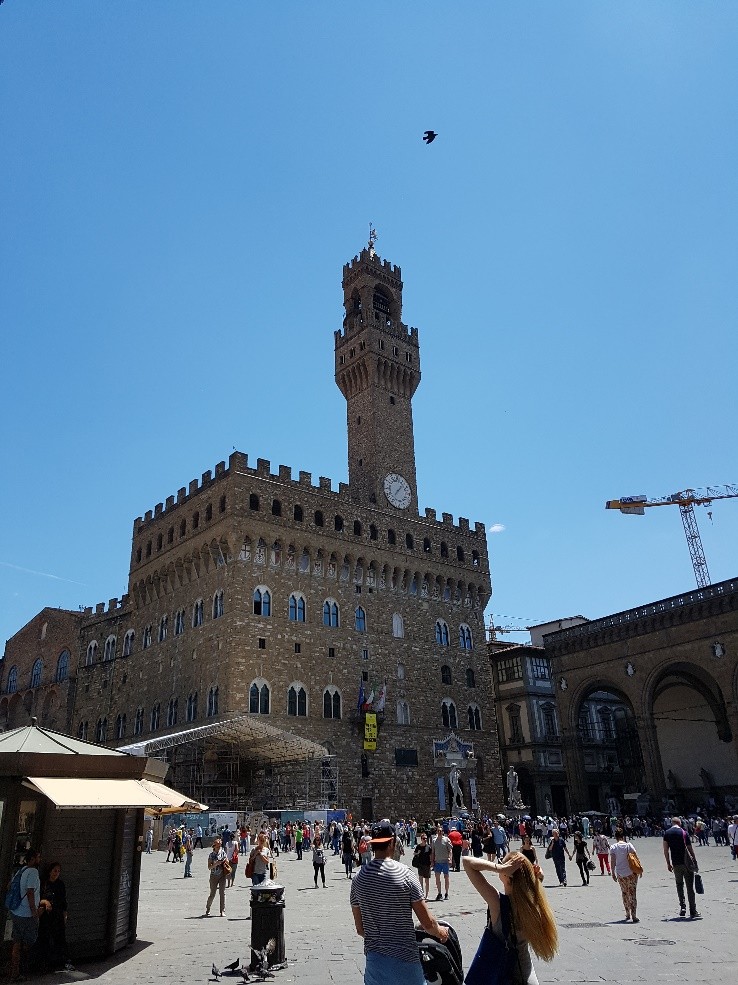
Florence’s city hall dates from the Renaissance, topped with the obligatory tower and trimmed with Florentine crenellations, different from those of Siena or Pisa, with whom there was much skirmishing to and fro.
Sadly, the Palazzo Davanzati was closed for the day, so we walked over the Ponte Vecchio again to get milk, which we had forgotten the day before; on the way, I stopped at one of the gold stores to start shopping for some nice Florentine gold earrings as my souvenir.
Miki had recommended a place for dinner that also had takeout, which sounded good to us early diners. We picked up a bottle of wine at a little wine shop whose clerk was an American girl with an Italian mother. As we neared the restaurant, we could their specialty—the Florentine steak, a huge hunk of porterhouse from the Chianina cow, barely cooked over a wood fire. We ate lasagna and broccoli instead, and enjoyed the wine (pushing our price point at 15 euros a bottle, but hey, we’re on vacation). After dinner, we strolled down to the Uffizi courtyard, a hotbed of street musicians in the evenings. Good musicians played every few feet. We stood at the Arno for a few minutes to admire moonlight on the water, and then walked back, enjoying the lovely, well-gowned young violinist playing in the now-empty Mercado Nuevo arcade.
Monday, May 22
While we ate our morning cereal, while read to me from the Washington Post about how bad cereal of any kind is for you, except raw steel-cut oats. Or lentil soup or some such non-breakfast thing. For now, we must carry on in a land where oatmeal and eggs are not breakfast.
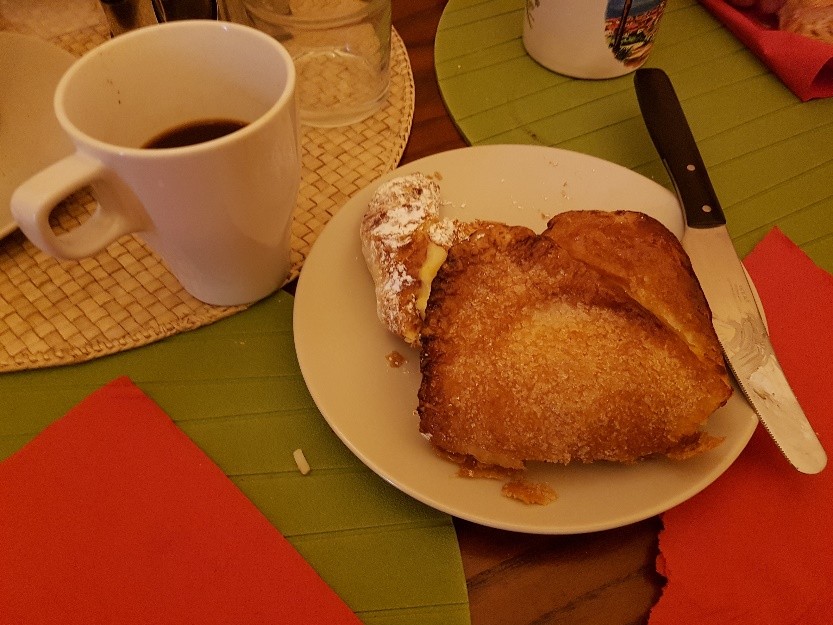
Sweet roll is breakfast here, so after our cereal we walked
to the bakery four doors down and got delicious sweet rolls. Thus fortified, we set out for the Duomo, the Accademia, and Mercato Centrale, jostling with the long rivers of tour groups crowding the streets.
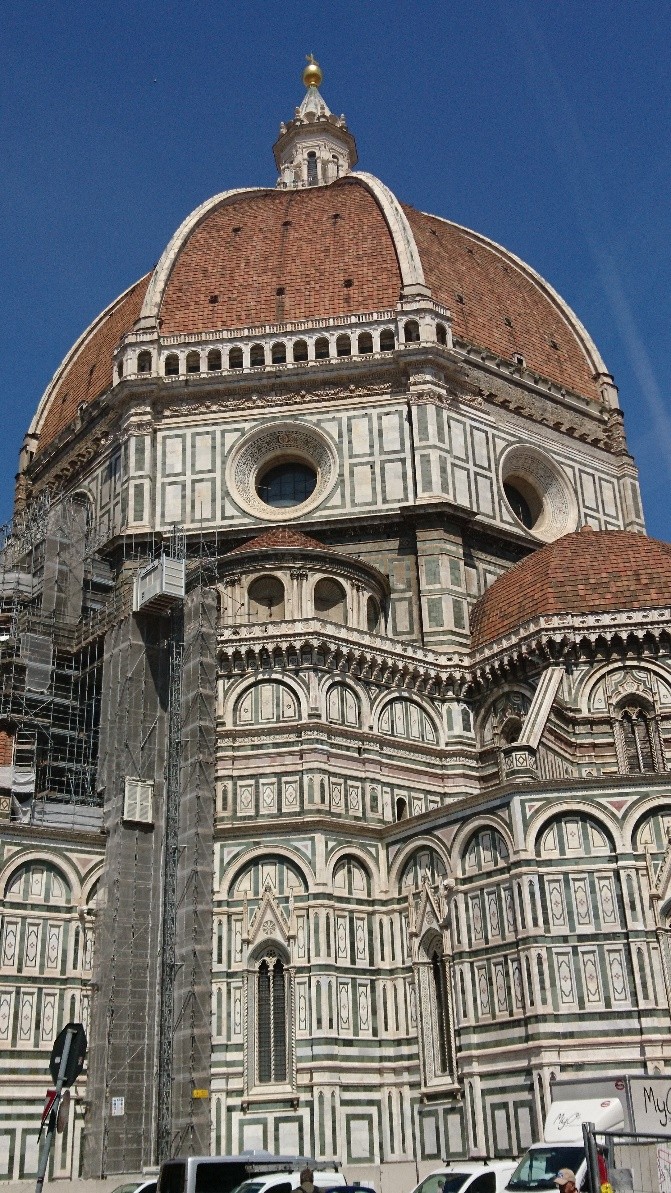
It was optimistic of the 1200’s Florentines to build a huge cathedral like the Duomo and leave a big hole in the roof, waiting for technology to catch up with their desires for something dome-ish. In the 1400’s, Brunelleschi said, “No problemo!” He put up some ribs, figured out a bit of internal support, and starting spackling it with squarish terra cotta roofing tiles, and the result was magnifico, lasting now for more than 500 years. The attractive striped marble outside was not applied until the mid-1800s when Florence was briefly the capital of the newly unified Italy.
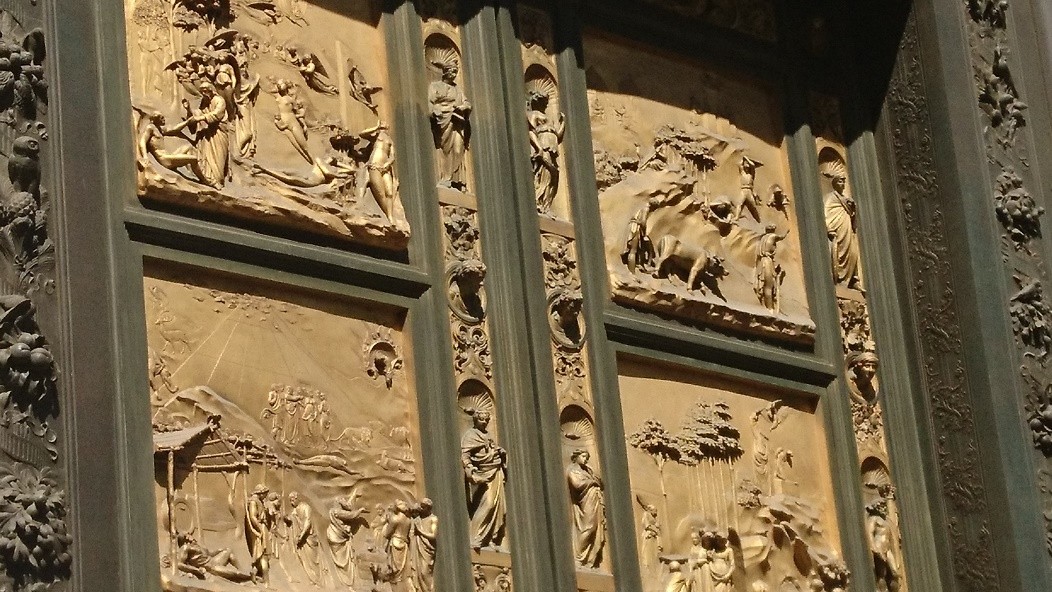
We admired the Baptistry doors. The originals are kept in the Duomo museum, which sadly for us was closed that day.

As you walk through Florence, beautiful old buildings display ancient, faded frescos.
On we went to find the Accademia, straight up a street and impossible to get lost, we thought.
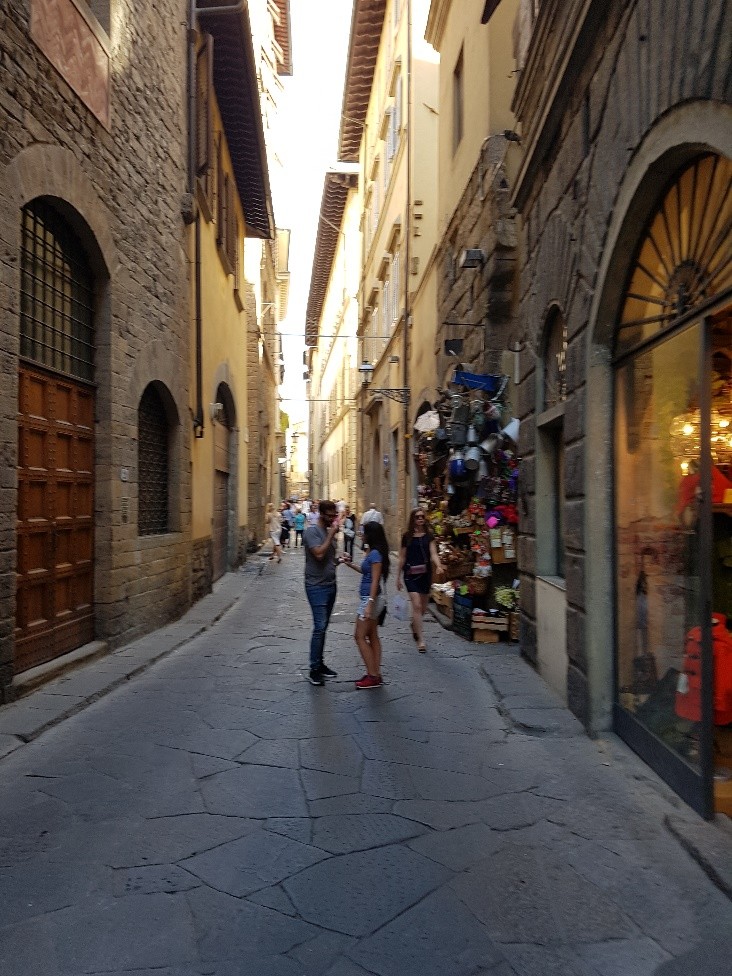
No one was lined up when we got there, except a few other people going up the steps into an office. We went up too, and the woman in the office glanced scornfully at my Firenze card, said “This is a school, madame,” and refused to speak again. We went back outside and walked around the corner, looking for some other entrance. There was no other entrance, but there were steps to sit on, so we sat. Our legs were glad for a chance to sit, which is not encouraged in public in Italy. I googled the Accademia, and there was the building, so we were in the right place. Jerr, however, was smarter—he looked up the hours of operation and informed me that it was closed, despite my list of what was open when.
So much for research. We moved on, making for the Mercato Centrale, a covered market that was the hot thing among Florentine foodies.
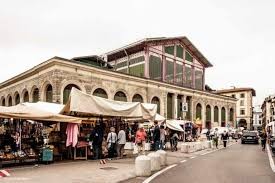
Of course, we found its back side, which was closed off for massive construction, and trudged a long way around to find the front side. Inside, it’s full of meat counters and produce stalls that also sell cooked foods featuring their wares, places selling sausages and souvenir-sized bottles of olive oil, balsamic vinegar, and other condiments. Being hungry, as we had been since we started walking 5–6 miles a day, we had lunch, sharing a plate of noodles sauced with what the booth wrangler claimed was wild boar ragu, split with pesto ravioli, and a mixed salad, which most of the salads I had in Italy, was full of tasty lettuce and tomatoes, carrots and artichokes, as well as chunks of ricotta salata. Here, as in Rome, they put cruets of olive oil and vinegar on the table and you mix your own dressing.
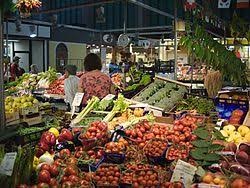
After our lunch, we wandered the market, looking at the yellowness of many naked, dead chickens, the huge slabs of various kinds of meat, the beautiful produce, from which our salad undoubtedly came. We bought some strawberries from a vendor (carefully not touching, because they hate you to touch anything), asking if we could have half the amount displayed in a basket. Sighing hugely, he complied. But when I asked for une pomodoro, that was going too far. He put five in the bag, along with the strawberries, and it was still only a couple of euros.
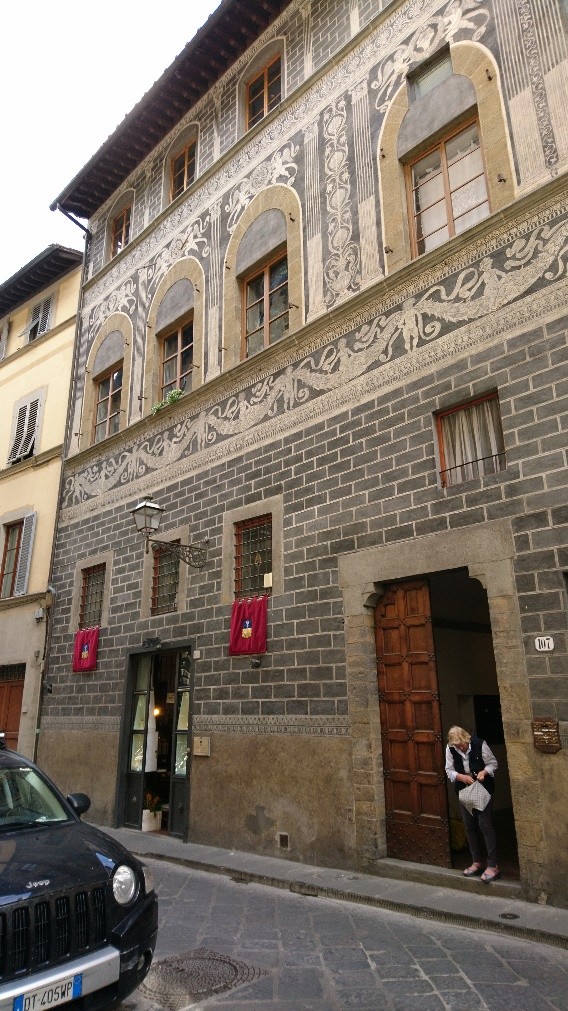
On our way back, we stopped at the Palazzo Davanzini, which is in a state of high preservation from its origins in the 1200s. We didn’t see all the rooms, but the master bedroom has been furnished appropriately. In a small room off it is a wide, shallow bath basin in the floor, where the lady of the house was bathed. I am wondering if she just stood in the basin, as Venus is shown doing in her Botticelli portrait (although she stands in a seashell floating on a charming nest of seafoam and cloud) whilst the maids poured the water over her.
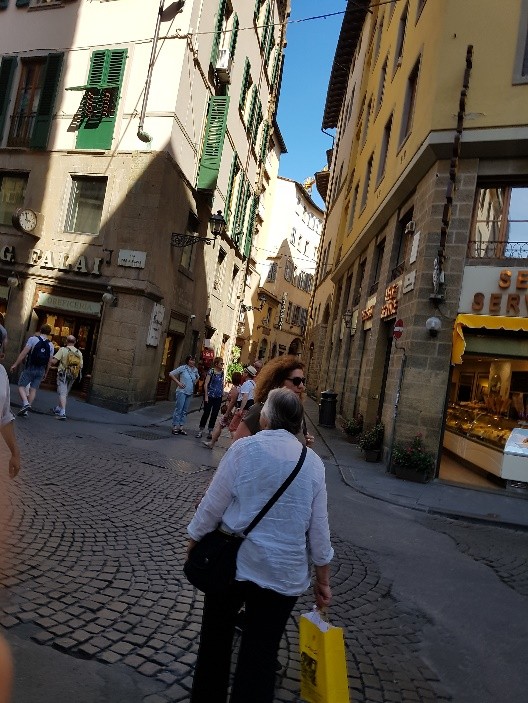
Florence is a great shopping town. We stopped in at Alberto Pozzi paper store run by the great-grandson of its founder, which marbles its own paper and gold-stamps leather items, especially its own hand-bound leather journals and albums.
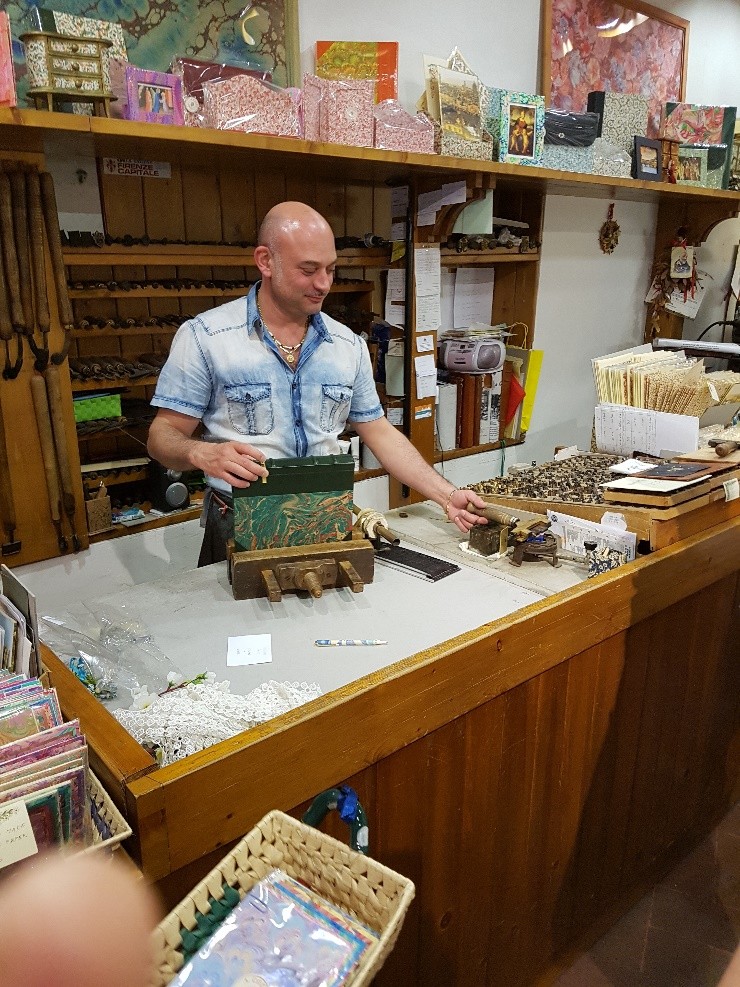
I loved the apothecary at the Santa Maria Novella church, a lavish temple to scent where everything is very pricey, but fun to look at, with a glimpse into the Santa Maria Novella courtyard.
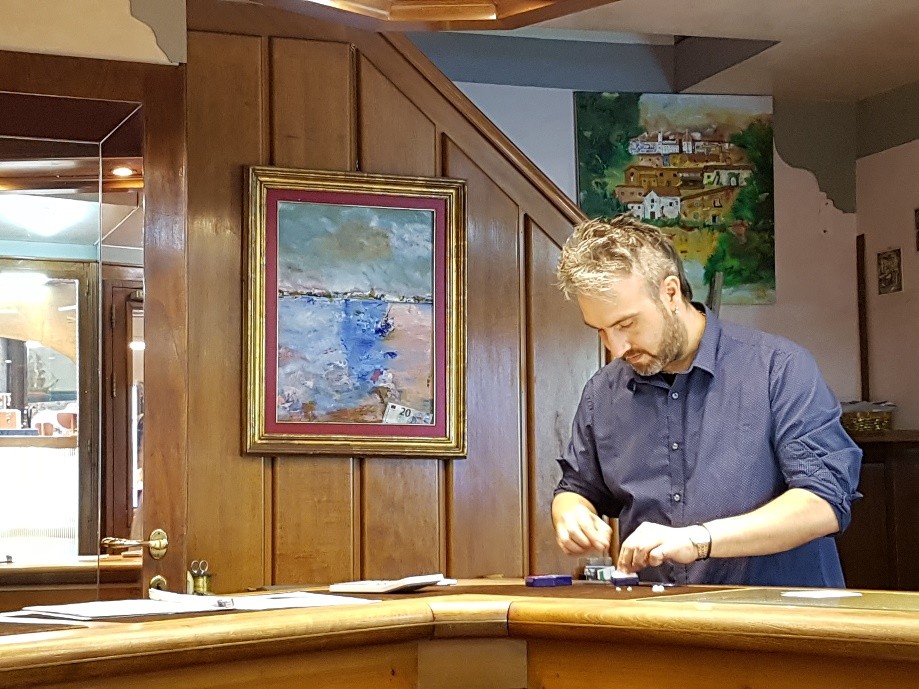
After hearing that all the shops on the Ponte Vecchio are owned by the same merchant, despite having different names, I liked Oro Due, a well-recommended goldsmith not far from our apartment with a good selection of earrings. The salesman/fabricator was very nice and filled out the detax forms for us.
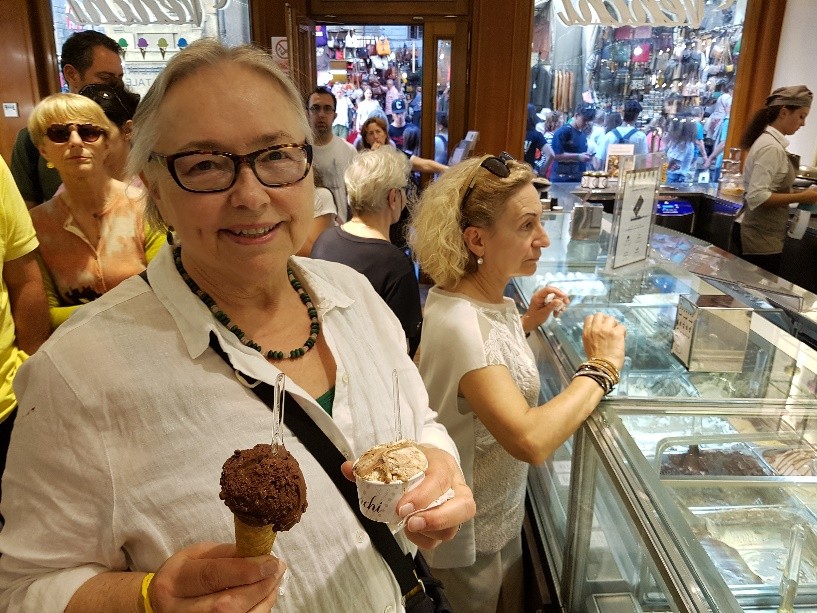
After all that shopping, we needed a pick-me-up, and gelato filled the bill.
Finally we made it back to our apartment sanctuary, footsore and laden. We made sandwiches with the bread we got that morning, and had a lot of sliced tomatoes. After watching Trump read nicely from his teleprompter in Israel, we headed to bed.
Tuesday, May 23
Up by 7 to find news reports about a terrorist attack in London at the Arianna Grande concert. We were horrified that terrorists would target, of all things, pre-teen girls. As we left the apartment, we noticed an increase in military personnel in the streets; they were present in droves in Rome, which we put down to heightened security around the G7 summit in Sicily, and noticeable at all the train stations; but several different kinds of uniformed soldiers carrying big weapons were standing in front of buildings and walking purposefully through areas with lots of tourists.
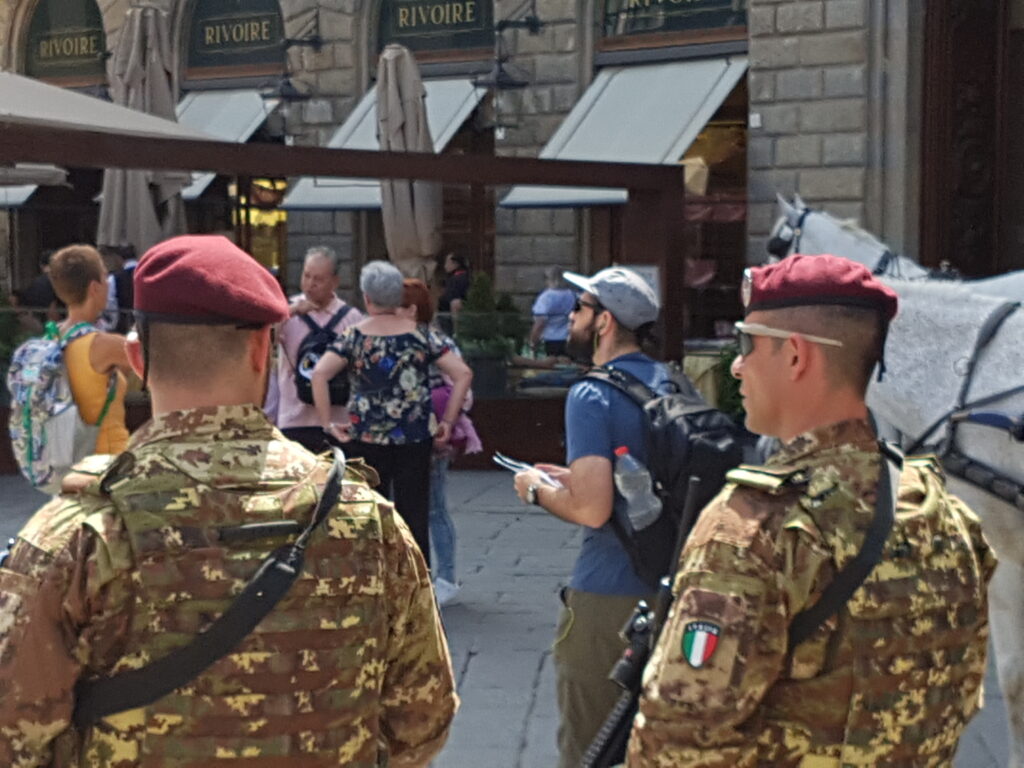
We headed past the Uffizi to the Galileo museum, full of fascinating things. Galileo evidently needed a lot of telescopes.
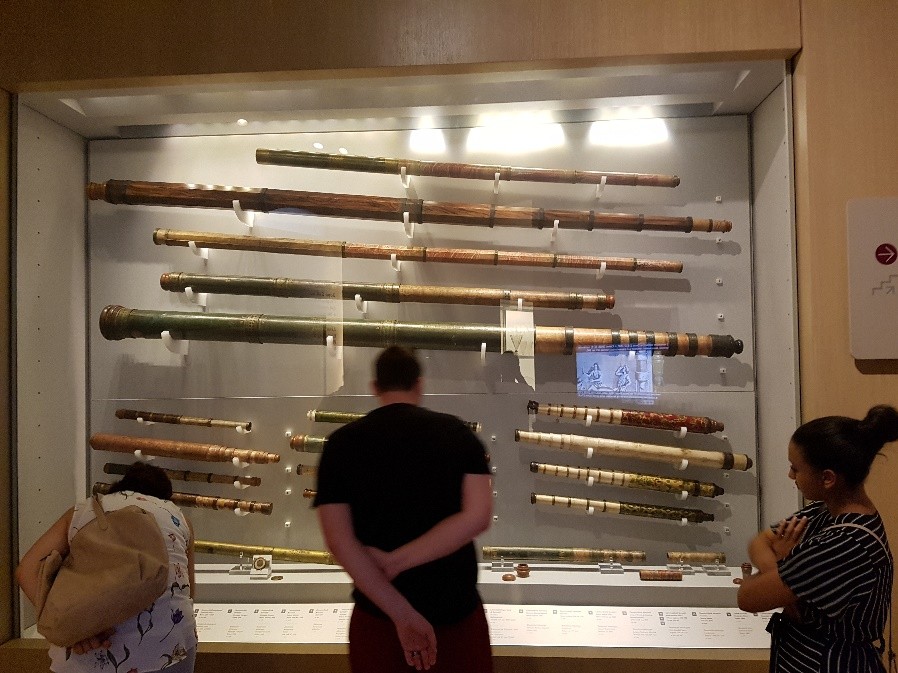
Jerr geeked out over old measuring devices and I admired Duke Francesco’s huge, gilded armillary sphere.

Afterward, we set out across the Ponte Vecchio and straight uphill to the Pitti Palace.
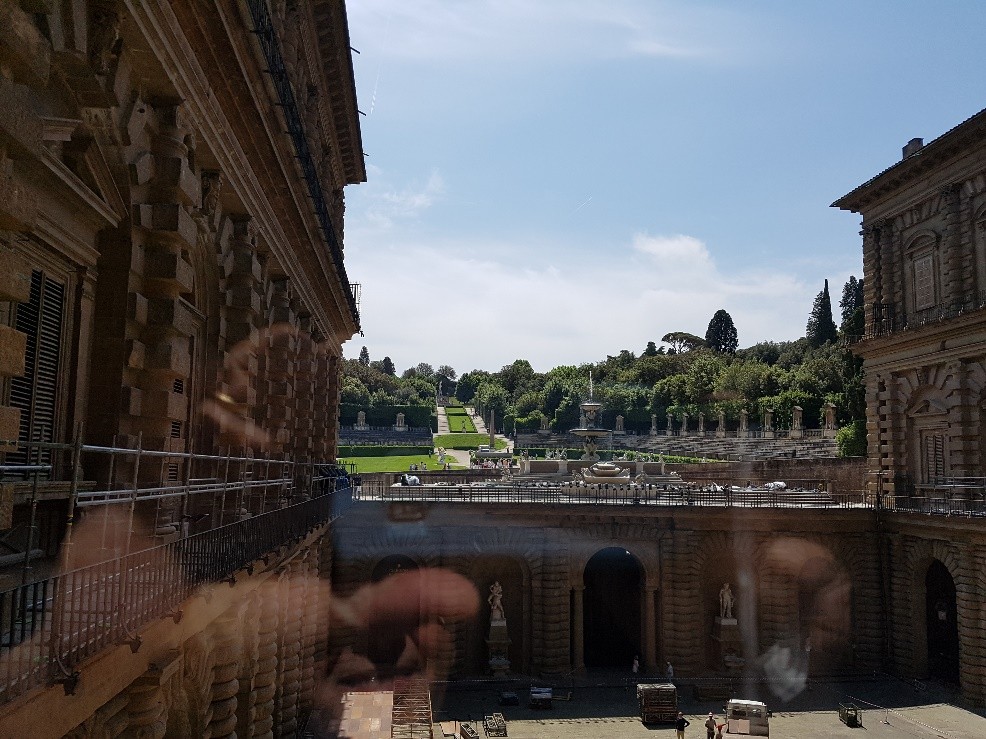
By this time I was growing weary of rosy-cheeked Madonnas with fat infants, but wanted to see paintings from the Macchiaioli, the Italian Impressionist painters. After rooms full of Madonnas and fellows in ruffs and women wearing fabulous ropes of pearls, we finally found them. Never did find the silver museum, which I have a hunch I would have really liked. But you gotta save something for the next trip, right?
After lunch at home, we set forth again, hoping to finally achieve the Accademia. We were in danger of getting bad cases of museum aversion, so we planned to breeze in during the late afternoon, see what we wanted, and breeze out. However, even the Firenze card line was long
At last we got in, amid the usual scrum of other tourists, and David was really worth the wait.
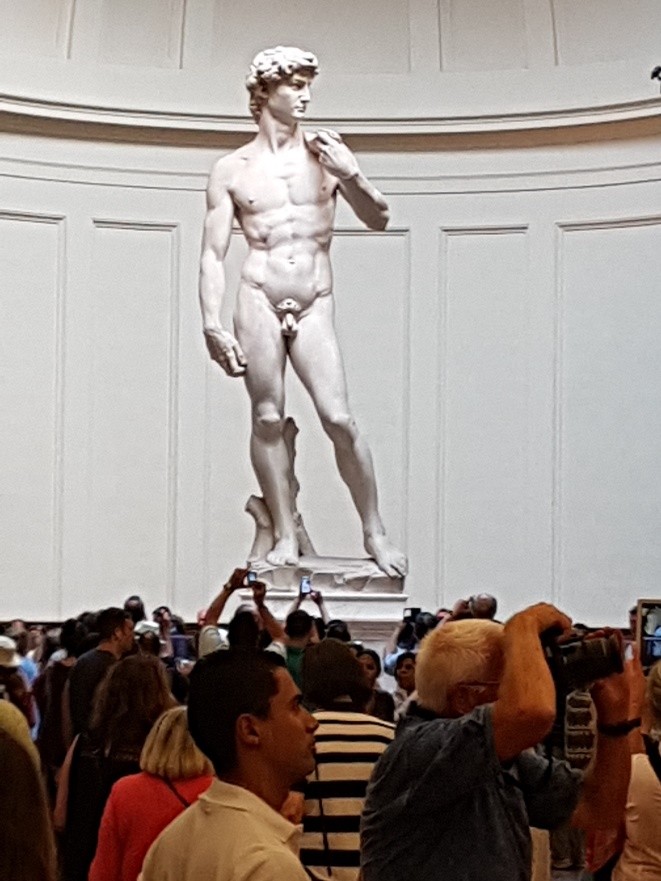
David is obviously the rock star of the gallery, and for good reason. He almost seems to breathe (and maybe ask what happened to his clothes).
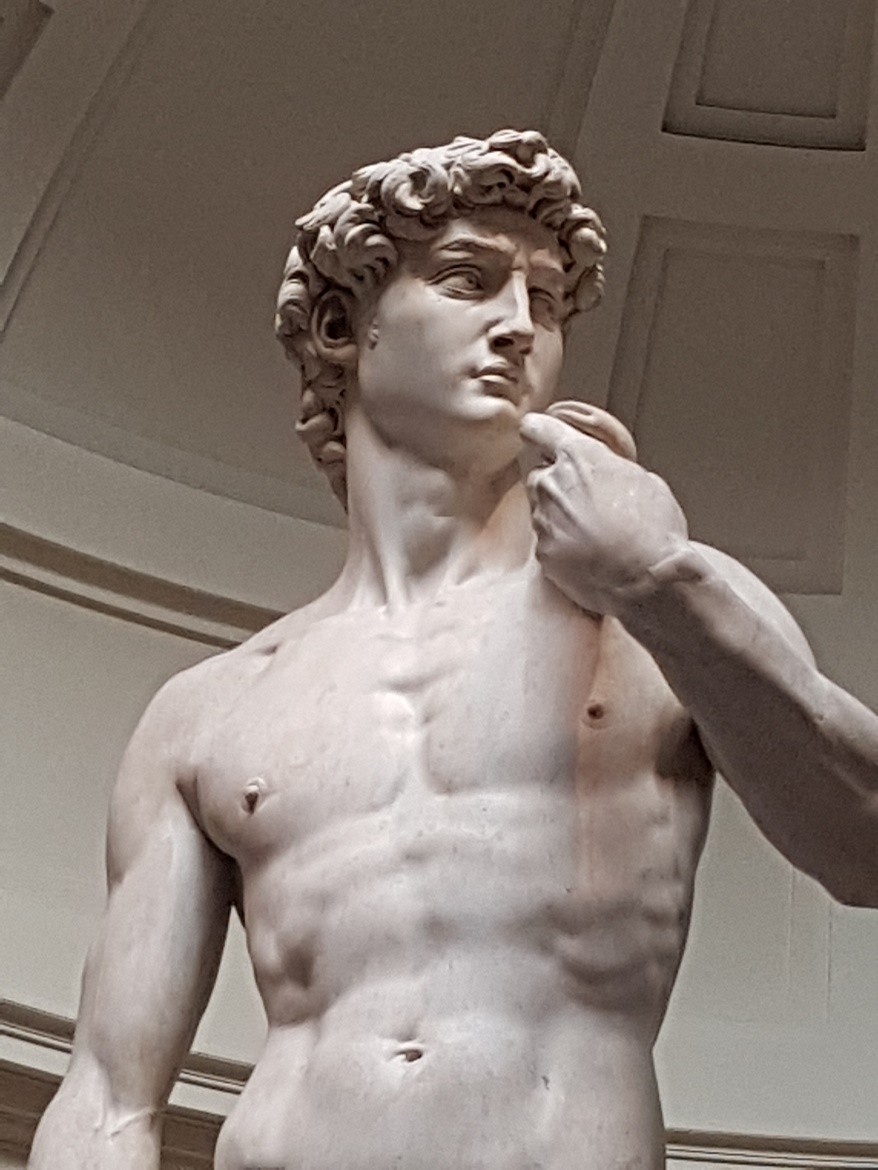
The block from which David was carved had a major flaw running through it and had been rejected by the other sculptors. Michelangelo didn’t worry about it. He went to work on it and depended on God to guide him. It seems to have worked.

The Prisoners, unfinished sculptures still trapped in the marble, were also interesting. His chisel marks show how he sculpted, just whaling away at the marble from front to back until the form was revealed, instead of working from drawings laying the figure out on the block.
An adjacent gallery had period musical instruments which we enjoyed viewing.
Since we hadn’t yet, we decided to eat the signature Florentine dish—giant hunks of meat cooked over a wood fire—for dinner. We chose Trattoria dall’Oste Chianinera for our bistecca fiorentino. Jerr got the giant hunk of meat, and I got some gnocchi (and a few bites of steak as well).

His dinner came with pici, which turns out to be biggish spaghetti (traditionally hand-rolled, but these were not) with a rich meaty sauce. We thought the meal came with salad, but we were wrong. So it was all carb, all fatty meat.
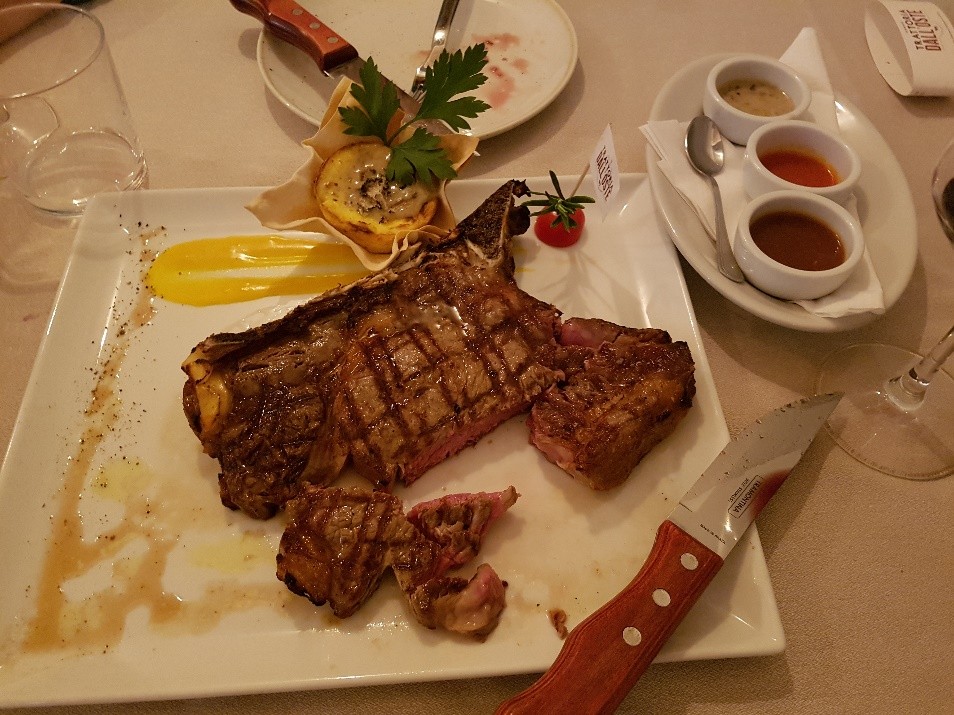
The steak is a porterhouse, and they ask how you want it cooked. Jerr said medium, which surprised me, since he likes it rare usually, but sure enough it was rare as he predicted. If you said rare, it might be raw. It was good, very flavorful, though I do prefer those prime filets we cook every once in a while as being less heavy. My gnocchi were excellent too. We waddled out of there and went home in a food coma.
Wednesday May 24
Got up early to get ready for our Accidental Tourist cooking class. We were to be picked up at Piazza Demidoff, about a mile across the river, and driven out into the countryside, to San Donato in Collina, where the class would be held in an old farmhouse centered by an 800-year-old tower. While waiting for our driver, we got acquainted with Luke Douglas and his lovely wife Steph, a young couple from London who travel around Europe on their holidays. When they mentioned they were celebrating their first anniversary, I ruthlessly topped them with our number (47).
About 10, our driver, Steve, arrived, herded us into his van and plunged into the Florentine traffic, gradually leaving the city behind to wind through hills until we arrived at a hilltop where the business was centered, just outside of San Donato.
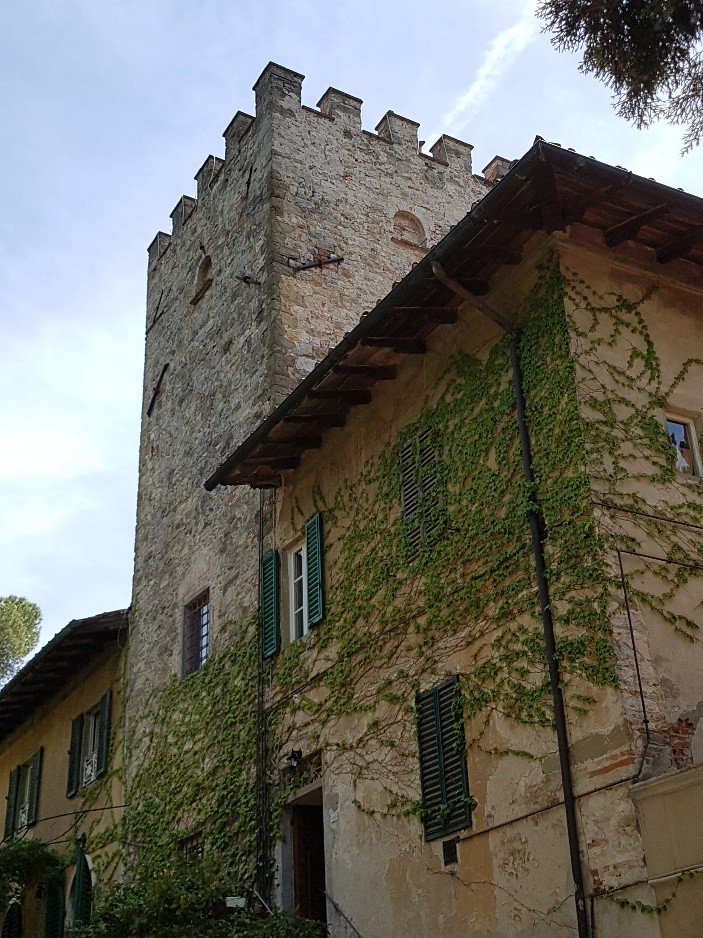
It was rural, with meandering paths through the trees that shaded the buildings.
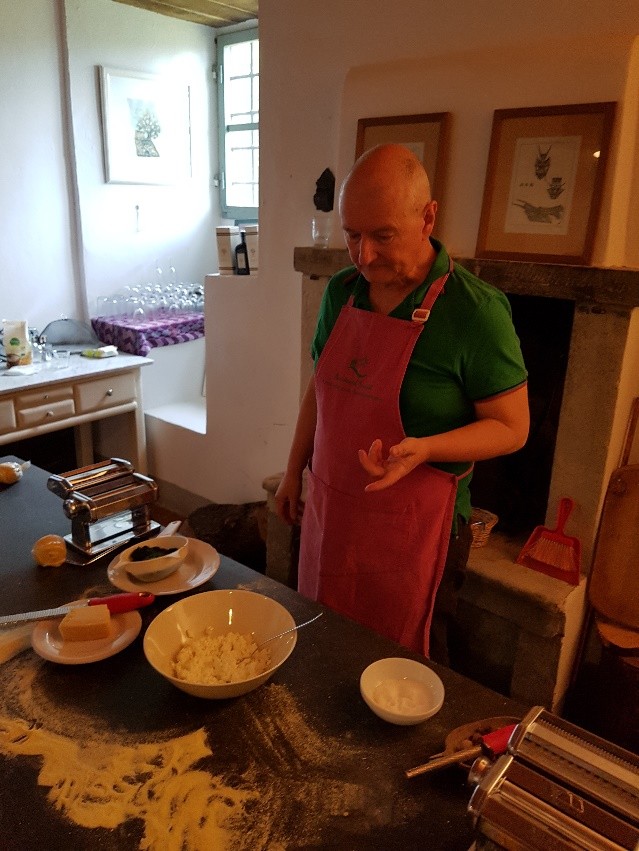
Steve led our class very well,
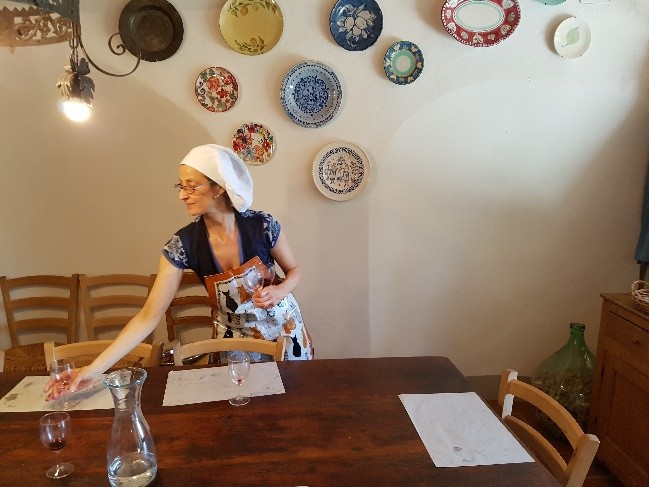
and Lucia was busy in the kitchen arranging our snacks and getting ready to cook our efforts for lunch.
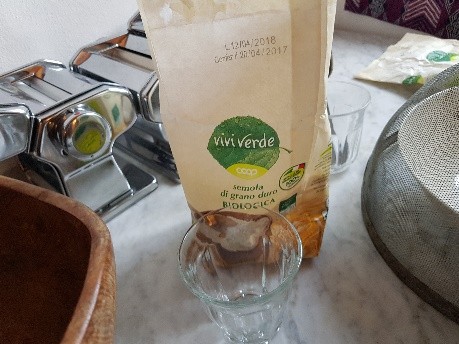
We used Vivi Verde semola di grano duro, an Italian flour with a texture more like finely ground cornmeal than American all-purpose flour. We measured about 100 grams each of flour onto the slate-covered table in the farmhouse kitchen, made a well in the middle per Steve’s instructions, added a pinch of salt, and broke an egg into the flour, mixing it in with our fingers and adding a little more flour until it was no longer sticky as we kneaded it.
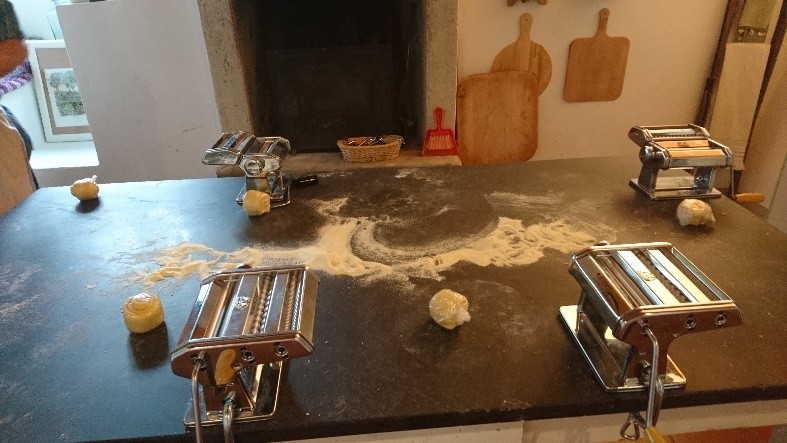
When it was right, we wrapped our lumps of dough in plastic wrap and had a glass of wine while we, and the gluten, relaxed by checking out the beautiful day outside and the beautiful view.

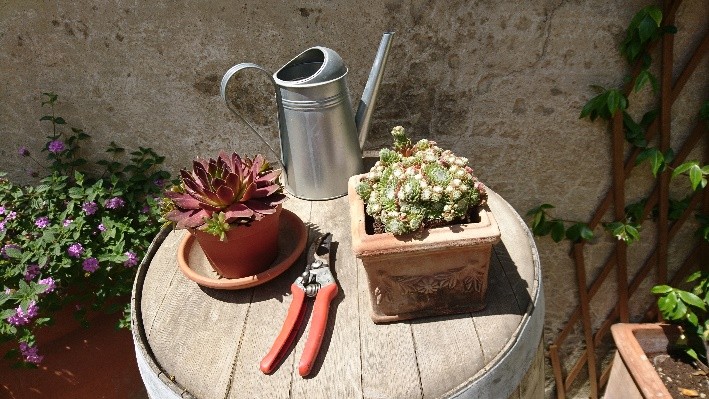
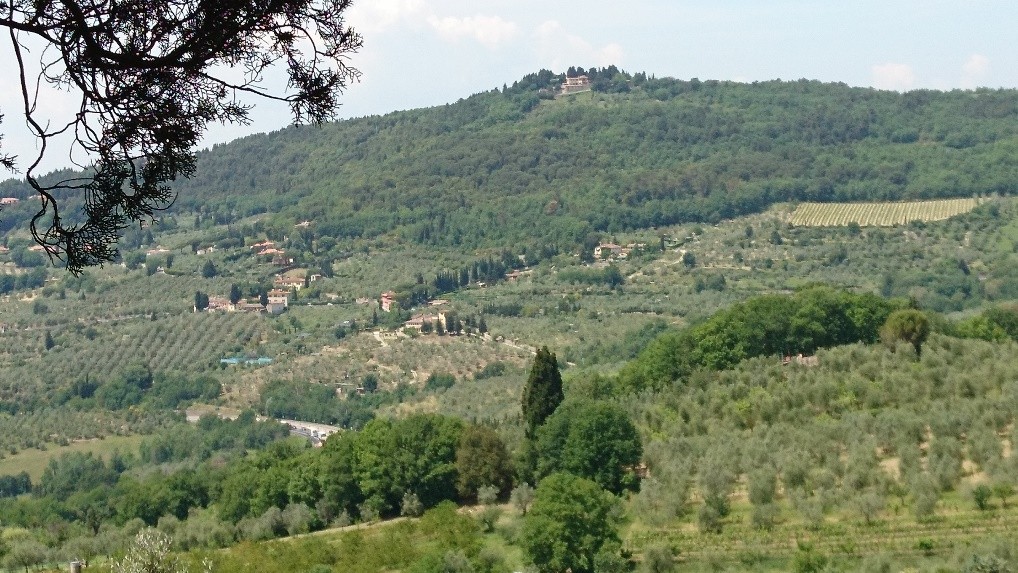
After about 20 minutes, we went back inside to use our pasta machines. We cranked our dough through the no. 0 setting once, then once again the other way, to make it more square. Then we cranked it through again, stretching with the left hand while cranking clockwise with the right. Then fold the pasta into thirds, pound it with fist or palm on both sides, knuckle it, pound it again, use the palm to flatten it more, and send it through again. We did that 10 times, and then folded it lengthwise, cranked it through one more time, rolled it up like a cinnamon roll, and wrapped it in plastic wrap to rest while Steve made the ravioli filling.

He had about 16 oz fresh ricotta, which was very soft and creamy, and more than a cup of barely steamed spinach, from which he squeezed the water, mentioning that if the filling seemed dry, the spinach water could be used to moisten it. He minced the spinach up nicely with a mezzaluna and mixed it into the ricotta. Then he grated a lot of parmesan into it—probably a cup and a half. Then he grated a goodish amount of nutmeg in—probably at least a teaspoon, and mixed it until it was homogenous
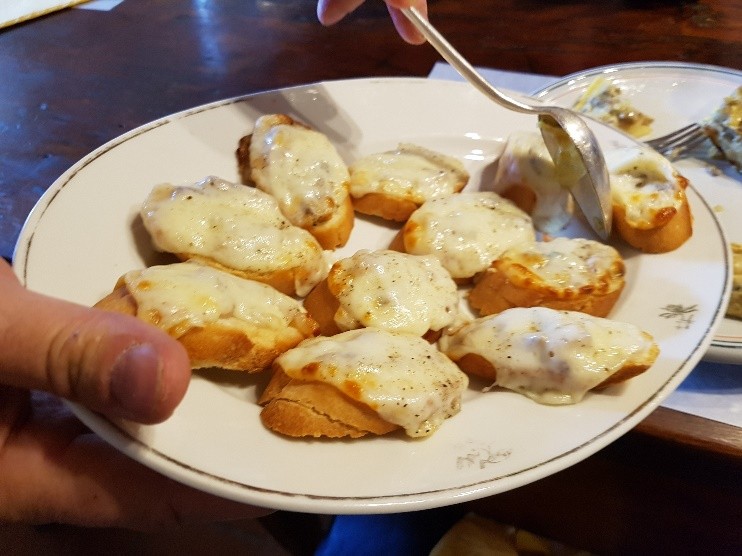
We had a break, with glasses of wine and bits of Tuscan bread toasted, salted, and brushed with wonderful olive oil that is pressed and bottled across the road.
Back to the machines. We used a third of our dough to make long ribbons of pasta, as wide as the machine, cranking it through 7 settings until it was thin.
We used 3-inch cutters to make rounds of dough, and gathered up the scraps to add to our other 2/3 of dough.
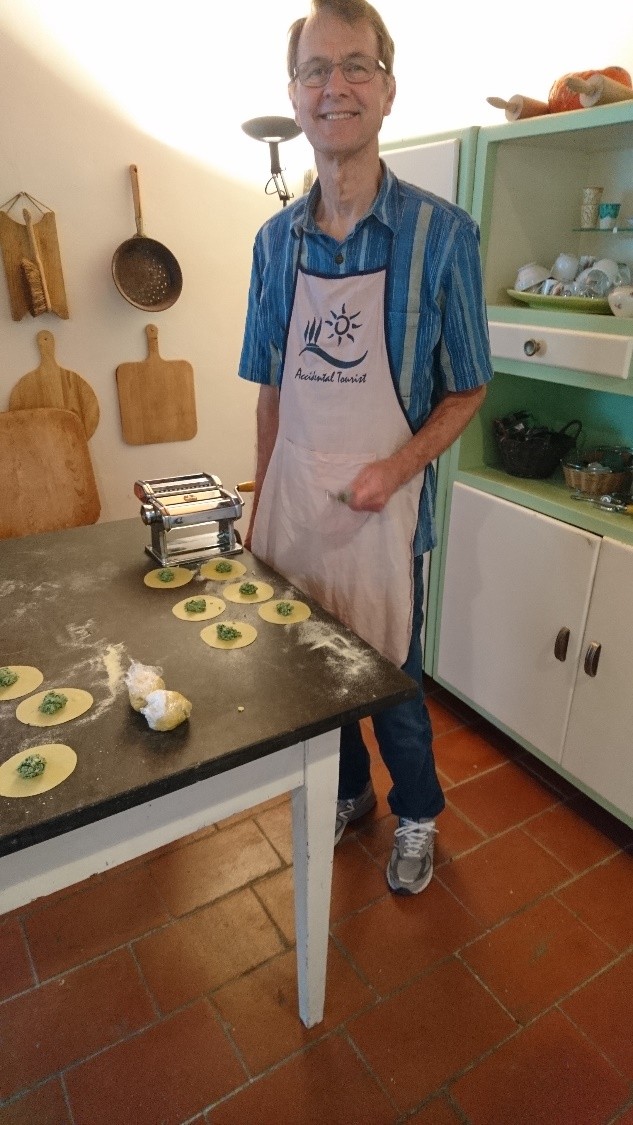
With two small teaspoons, we scooped a blob of filling, rounded it with the other teaspoon, and plopped it into the middle of one of the circles, repeating until we were done. Then we used our fingers to shape the blob of filling into more of a log across the middle. This we mined gently for moisture to go around the edge and help seal the dough edges. We pulled the top half over the bottom half, pressing out air bubbles and flattening the filling somewhat, then pressed around the edge to seal, using our thumbs the second time. We went around the edges with a fork, then with a pastry wheel, to make a pretty package.

As Luisa worked away in the kitchen at other aspects of our coming lunch, we made tagliatelle by unwrapping our last piece of dough, cranking it through the settings as before, and then through the wider noodle cutting area of the pasta maker, then tossing the ribbons with semolina to keep them separated.
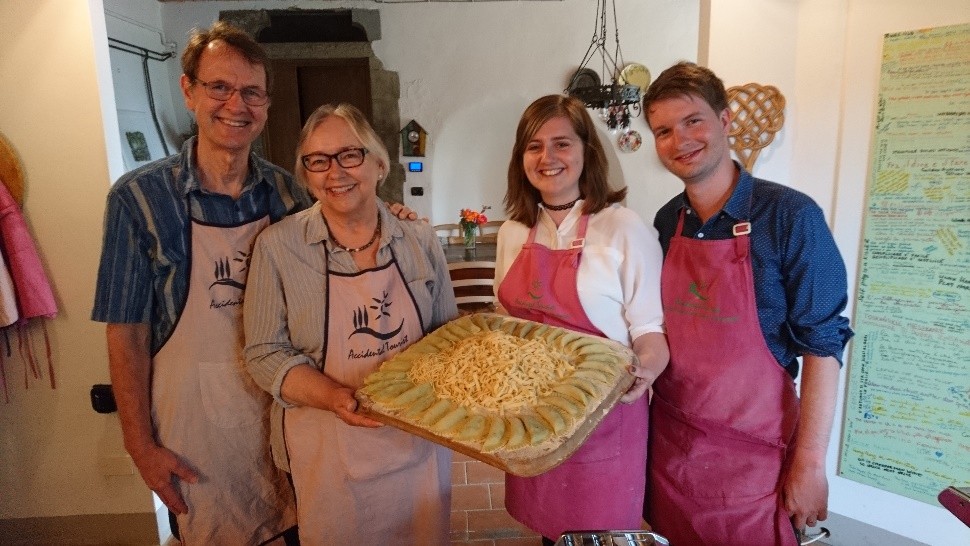
Two kinds of pasta, made by our own hands.

We moved over to the dining table and the delicious antipasti Lucia had prepared: a puree of sauteed eggplant, ricotta, scallions, and parmesan and maybe a couple of other things—I had drunk some wine at this point—used to dip fresh veggies in, or spread on bread; a most delicious potato and artichoke frittata; and rounds of baguette brushed with olive oil, toasted, topped with a small slice of ham or prosciutto and a goodish amount of pecorino, then broiled briefly to melt the cheese.
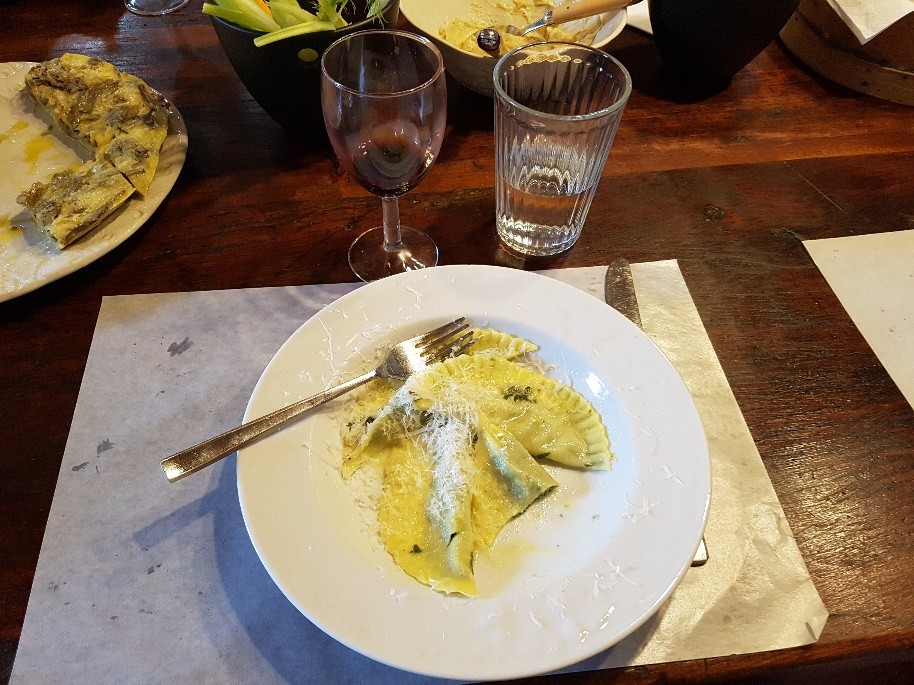
Luisa prepared our ravioli with butter and sage, crowned with freshly grated parmesan.
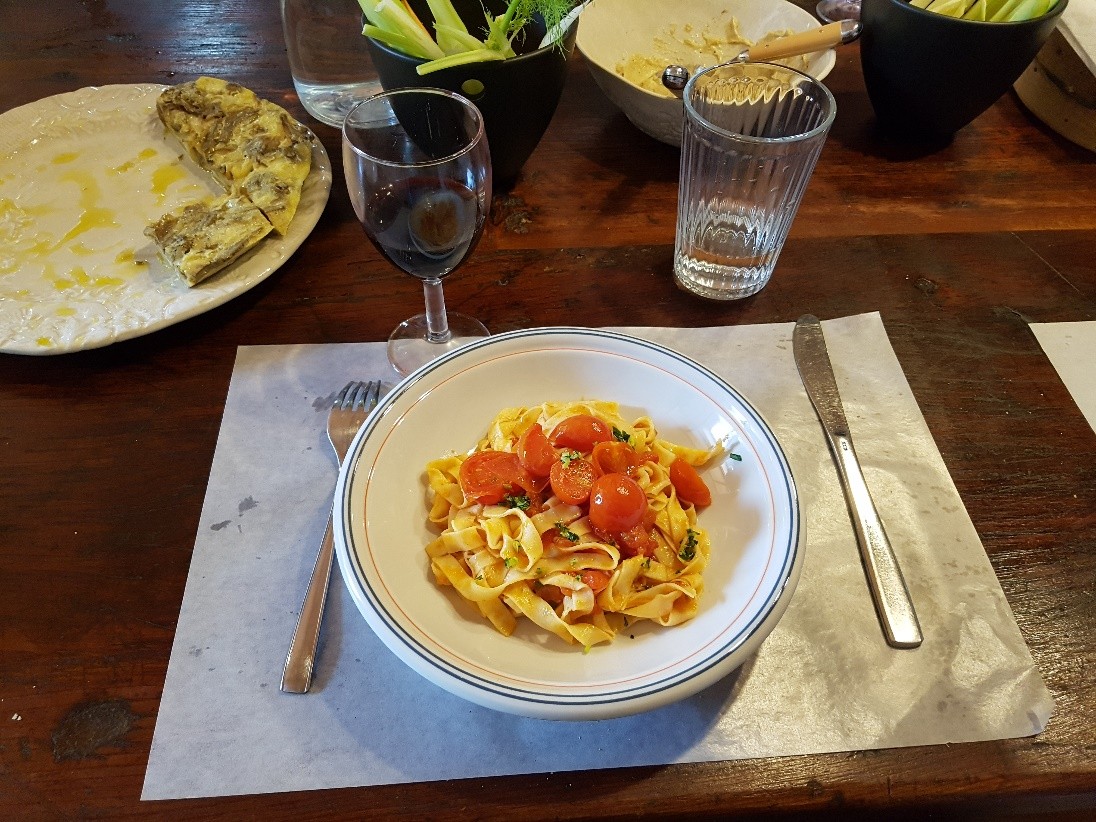
Luisa then brought out our tagliatelle, perfectly cooked and sauced with a fresh red sauce made from cherry tomatoes, a bit spicy. Everything was delicious and really impressed us with the pasta makers (and of course, Luisa’s mad skills).
Full as we could be, having finished the wine, the pasta, and our time, we climbed back in the van to be transported to town. It was a fabulous excursion. We both agreed this was a highlight of our trip.

Later that afternoon, we walked around Florence touring the crafts galleries and seeing astonishing things, like this motorcycle cared out of wood in the shop that also sold various sizes of Pinocchio. Florence is supposedly the birthplace of Pinocchio.
We’ll be moving on to Venice tomorrow. We’ve enjoyed Florence, though I’m sure Jerr is happy to leave the museums behind. It would be better to come when fewer other tourists are around, if only to dodge the long trains of tour groups clogging up the very narrow sidewalks. But I’m so happy to have been here. I know there’s a real Florence on the other side of the river that’s cramped and probably expensive. The apartments we’ve stayed in have gotten too expensive for their original inhabitants to occupy, so they move farther from town and rent their family place to tourists. Miki and her husband and son still live in the building where our apartment was located; they inherited at least two or three apartments, and perhaps the whole building, from her parents. But most of the Florentines, as most of the Romans, don’t live in the beautifully preserved historic part of town—the Centro Storico. It feels as though you could come across Michelangelo’s studio and watch him having at the blocks of marble around any corner.